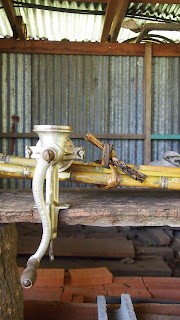Happy one month anniversary in Costa Rica, CIEE! Did that go by quickly or what?
Not a moment to lose. I plan on dragging people out of bed to come hiking at five; that leaves me a good half hour to check over my exam and finish this up before I head out. Certainly capitalizing on my early morning preferences here.
The last three days here have been increasingly homework-oriented, which is good, because I really feel like I haven't been in school since ochem ended last May, for various reasons. It's so easy to be motivated to work when you're studying topics like insect diversity, life zones, canopy layers (just like the good old days with Spin: http://www.youtube.com/watch?v=CulERHkwsTo ), and more interestingly to a non-economics/non-social science major, coffee production and agriculture in global markets.
The picture tour begins now.
After a "standard" day of lectures and Spanish on Monday, Tuesday hailed dark and rainy. We were told that we would be teaching lecture (different plant growth zones/types in the forest) and that we were to use our new-learned plant identification skills to go out and find samples to aid in our presentations. Some of us used this as an excuse to go crashing over mud-slick rocks and leaf-littered slopes to climb back inside the strangler fig. Finally got to use my "Rite in Rain" notebooks in the rain, and finished my 200 page journal that I started February 8th. Probably a record for me.
After Tuesday's adventures, which included a long afternoon hike to the TV towers, Wednesday found us going on another field trip to coffee farms. We stopped to look down on San Luis and listen to Alan lecture for a bit.
I hope to do my month homestay in this farming valley. You can't see it, but in the valley, there's a huge waterfall. It'll be an hour walk to the field station from here. Want want want.
The first coffee farm we visited was a small, 4 ha, shade-grown coffee and inter-cropping venture owned by a man named Eugenio. I was particularly excited about these wild avocados: apparently they're quetzal and bellbird favorites. There are a few near the station, and Johel says the bellbirds should be arriving to breed soon. Excitement.
Eugenio grows and harvests naranja, papaya, bananas, plantains, corn, tomatoes, lettuce, sugarcane, palmito, and of course, coffee. As a wannabe farmer girl with limited knowledge about organic California small farms and large factory operations or industrial farms in the midwest, I have to say that learning about sustainable farming in the tropics was a beautiful thing.
Beautiful -and- delicious. The bananas here are so small and sweet. Omnomnom.
Some life goals: make myself a leather journal, backpack, machete sheath, and belt. Also to be like Eugenio and try to impress upon the next generation the importance of staying close to the land.
I hope I'll always have chickens and gardens. Planning on it.
A coffee/corn grinder in front of a sugarcane bundle. Eugenio had this huge contraption for stripping the sugarcane of its pulp and outer lingin, leaving a sweet, thick juice behind. He produces a molasses-like sugar from the cane...it was delicious.
And then there was the coffee. Shown here drying after de-fruiting.
Coffee berries. Branko keyed us in on stripping the beans of their outer fruit and popping them in your mouth to taste the thin, gummy fruit layer before spitting them back out.
Eugenio. Super shiny eyes. I love small farmers.
Sugarcane!
Jealous cat is jealous of our bean, cheese, and chicken empanadas.
Eugenio's mother served us some of their home-grown, fresh-roasted coffee. I've started drinking the coffee black down here because it's just too delicious to pollute with anything else. Mmmm.
Farm hands.
Fantastic mugs.
After Eugenio, we spent the afternoon at the other CIEE location (for the Sustainability program) discussing the merits and setbacks of free market, fair-trade, organic, sustainable, and something I'd never heard of--direct trade--agriculture. Having never taken an economics class in my life, I really appreciated it.
The other CIEE location. Vibrant, quirky place.
With Taira, the lazy white wolf with piercing blue eyes. What a fierce and noble beast.
She likes empanadas, too.
Back to the discussion of coffee: many people are anti-fair-trade down here, saying that it's mostly a facade and an ineffective business model that doesn't make much of a difference for small farmers. To be certified organic or fair trade, small farmers in Costa Rica have to pay -thousands- of dollars, and maybe even hundreds more each year for inspections and the like. My view of feel-good-green labels has certainly changed after being down here: and I really encourage anyone who is really interested in social responsibility in agriculture to get out there and get to know the facts.
This is Alan next to Ken Landers, an energetic entrepreneur and ex-lawyer who has started Thrive Farmers: a direct trade operation that splits profits with the farmer 50/50, and takes coffee directly from the farm to the consumer. Check him out at http://www.thrivefarmers.com/ : direct trade is certainly a great idea in principle, and an even better discussion-sparker.
Thrive farmers does make -quite- delicious coffee. If you're in Monteverde, be sure to visit!
And with that, I've given my friends an extra 20 minutes of sleep and must be off. The sky is starting to lighten.
Cheers, all.























No comments:
Post a Comment